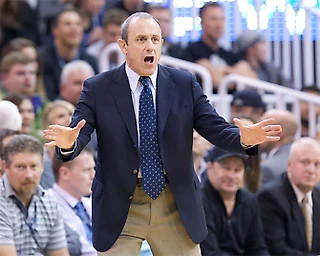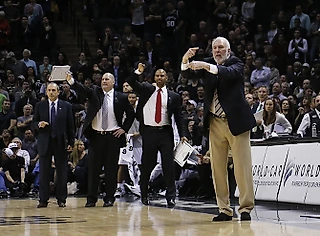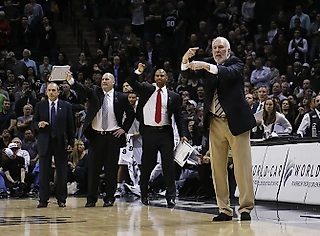Some defensive basics
In this post we’ll discuss our defense.
There are different ways to evaluate how good a team’s defense is. People generally tend to look at opponents’ points per game but that stat has an obvious flaw. As long as you play slow tempo and keep number of possessions low, you won’t concede a lot of points. But that doesn’t mean you’re good defensively.
For me, basic indicators are opponents’ shooting percentage (both 2’s and 3’s), opponents’ points per possession and rebounding differential.
Those numbers clearly show that at the moment CSKA’s playing good defense. We’re definitely among Euroleague’s best defenses alongside Real Madrid and Panathinaikos. That’s encouraging because all the teams to win the title in the last 10-15 years were first and foremost great defensive units.
Compared to last year, we’ve definitely made a step forward. We have more depth and athleticism, we’re just overall a better defensive team. Just make no mistake – there are still things we have to work on.
The three guys we added this summer – Kyle Hines, Jeremy Pargo and Vitaly Fridzon – are all quality defenders, each in his own way. All of them have good size for their respective positions, which allows us to switch on pick-and-rolls more often. And in modern basketball being able to do so is a huge, huge plus.
Now, let’s dig just a tiny bit deeper and see what we’re trying to accomplish on defense. First, it’s paramount that we do not allow fastbreak points. Those occur when you take ill-advised shots or turn the ball over. Conversely, taking good shots within the flow of the offense usually gives you a good chance to grab an offensive rebound or at the very least to get back and set up your defense.
Another point of emphasis is eliminating second chance points. Box out, clear defensive glass, prevent opponents from running breaks – and you won’t let them score more than 55-60 points per game. It’s statistically proven, teams that average 80+ ppg usually count on 25-30 of them to come from fast breaks, transition and second chance opportunities.
As far as general assumption goes, you’ve got to be able to defend in halfcourt. Like, you have to know their plays and calls, be familiar with the system, etc. That’s correct, but to me it’s even more important to learn how to box out the right way. Especially in situations when there’s rotation and defense is moving because we have to stop a dribble penetration. Or after a pick-and-roll, when big man goes to the basket and at that very moment a shot is launched. What happens then? Who’s boxing out whom?
Mastering those situations and generally establishing good transition defense to me is just as important as being able to get stops in halfcourt. That’s why we try to include a box-it-out bit in every drill we run. Like, when we work on our fast break, we start from boxing out. It makes the whole drill more game-like, more real.
We also work extensively on our one-on-one defense. I believe that if all players make honest effort to keep their opponents in front of them at least for a couple of dribbles, you’ll already have a foundation for a good defense. Don’t allow uncontested penetrations, don’t let people come in front of you easily, never let opponents take low post positions without fighting for them. All these position-related things are very basic but at the same time absolutely vital.
Defensive tactics are important, but fundamentals come first. Footwork, first and foremost. How do you slide through screens? How do you go over them? What’s the right way to move when you’re helping and then rotating back to your man? How do you defend crossover dribbles? How to make sure you don’t buy every pump-fake? It may sound strange, but even a top-level professional team like us puts a lot of work into these little basics. We often set up one-on-one situations in practice and go over fundamentals again and again. Not only in pre-season, but during the season as well.
Another thing we do defensively is try to hamper or slow down the opponents’ ball movement. There are different ways to do it. A defender can use his body to force the ball to a side, i.e. force player with the ball to move it to his far shoulder, limiting passing opportunities. We also try to eliminate easy swings from one side to another. Slowing the ball movement gives your players more time to adjust to the new position of the ball after every pass. Consequently, the defense becomes less likely to be busted with a weak-side cut, offensive rebound and stuff like that.
One more nuance we work on a lot is “second help”. Today all teams know how to help when the ball is taken to the basket. That’s first help. The key is to know how to rotate and cover for the player who’s helping. And to know how to recover after that. Offenses are good enough to recognize the first help and the second help, and maybe swing the ball to the opposite side to find an open man. They’ll try to exploit everything you give them, you have to be aware and know your rotations.
And that’s something you have to practice a lot. Here you need not only techniques, but also communication, experience and ability to anticipate.
You need to read the eyes of the passer. Quite often it will help you understand his intentions a split second in advance. There are very few guys – and we’re lucky to have some of them here at CSKA – who pass without actually looking in that direction. Most of the players look first, pass second. Being able to read the opponent’s eyes is a big part of becoming an experienced player.
When I was coaching youngsters in Italy, I always taught them to read the opponent’s eyes and also note where he keeps the ball in regard to his body. Ball position is important because if, say, he’s holding the ball to his right side and there’s a defender pressuring him from the left, he’ll only be able to pass to the right or straight forward.
Tactically, you surely need to know a lot of things. But the bottom line in modern basketball is the ability to defend pick-and-rolls. Looking back, things have changed drastically since I first became head coach in Bologna. Back then we, just like all other teams, used to have one way of defending pick-and-rolls. Now there are many of them, and the factor that varies is the degree of aggressiveness with which you attack the ball-handler. Here you can go from the “red level” all the way down to a contained approach. We have several terms describing what we do – “show”, “down”, “flat”, “high-flat”, etc. This is something all our players need to be familiar with.
Now, during a game it may be necessary to change the way you’re defending pick-and-rolls two or three times. Here communication becomes very important. It’s one thing for a player to decide how he’ll defend, and a completely different matter to communicate this decision to a teammate who’s also involved in the play and is supposed to act accordingly. Granted, the way we’re playing against pick-and-rolls does not usually change on a play-by-play basis. We often do it at halftime or during timeouts. Still, you’re not always playing scholastically. Players’ own interpretations of what’s happening on the court are very important. A player may decide he needs to be more (or less) aggressive while defending pick-and-rolls. In such case, he needs to quickly inform his teammates, get them on the same page.
Switching on pick-and-rolls is becoming more and more popular. Naturally, offenses try to attack resulting mismatches. They’ll do it in the post if their big is guarded by a smaller player, they’ll do it on the perimeter if they feel the switch gave them speed and quickness advantage. But as the athleticism of the players grows, risks go down. Like, we have Victor Khryapa and Kyle Hines who have no problem defending guys on the perimeter. Or take Jeremy Pargo and Vitaly Fridzon. They can easily hold their ground against bigger players down low. They may spend a foul doing that here and there, but they won’t give up easy shots.
We usually prepare our team against opponents’ tendencies, their main habits. If they maybe have one or two special plays they like to run, we can pay attention to that too. But first of all we want our players to know what the opposing team likes to do in various specific situations. Like, who are their favorite weapons late in the game? How do they use them? With screens? Isolations? Should we double team or just stick to the one-on-one defense? We try to understand how the opponents want to play, rather than prepare against each and every play they run.
I have a colleague in Bologna, his name is Gianni Giardini. He already was an experienced coach when we were both working with younger players, and even when I went on to coach the senior team, I often asked his opinion on various matters. He’s still coaching, still a very popular basketball person in Bologna. Gianni once told me he preferred not to tell his players too much about opponents. He felt that if they knew too much, they could’ve started thinking they knew everything. And then the opponents would have a good chance to surprise, even stun them. He wanted his players to pay attention during games, to figure out whom they’re playing themselves.
That actually makes a lot of sense. If you feel you’ve done all the homework, you’ll go in there like the US army did when they faced Viet Cong. They thought they were prepared, but in fact enemies started coming from nowhere with bombs, traps and ambushes. And that led to one of the most disastrous wars in the country’s history.
So, don’t get your team spoiled with the illusion of perfect preparation. Perfect preparation doesn’t exist. What you can do though is push your players and demand from them better and better understanding of the game as well as improvement in their ability to react and adjust.
A question we sometimes have to answer is what to do when one of your opponents gets really hot. That by the way has happened several times in our recent games. In that regard, a conversation with one of the great players I worked with always comes to mind. He once told me that if he won his individual duel, we as a team would have a better chance to win the game. And if two of his teammates did the same, those chances would further improve. He showed me the value of those personal clashes, which can be at the basis of individual effort and by extension of the team’s success.
So from time to time, I let my player stay on the opponent who has a hot hand because I expect him to react and show some personality. I want him to say “ok, you scored on me three times, but now it’s over”.
As for strategies, there are two of them. You either try to stop the player who’s scorching you by sending double and triple teams and forcing everyone else to try and beat you. Or you let him get 50 and concentrate on taking his teammates out of the game completely, hoping that without offensive involvement they’ll start slacking defensively and your chances will grow.
Drawing the line here, you won’t go very far defensively without toughness, dedication, aggressiveness and commitment. They say that on defense fundamentals give you 30% of success. The rest is sheer will and mental toughness. Not taking anything from the importance of proper footwork and positioning, but this is probably true.







